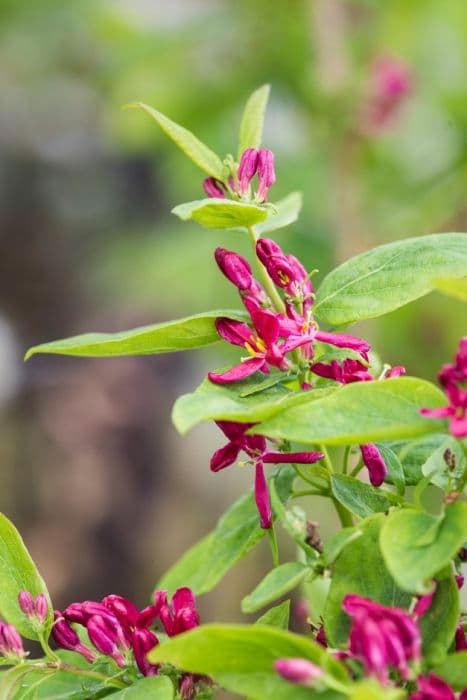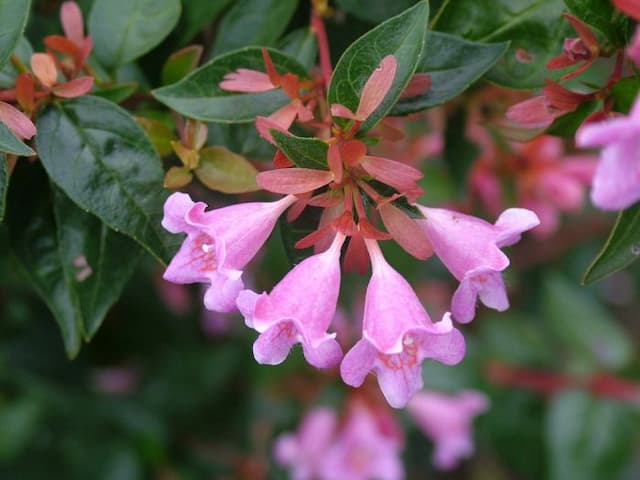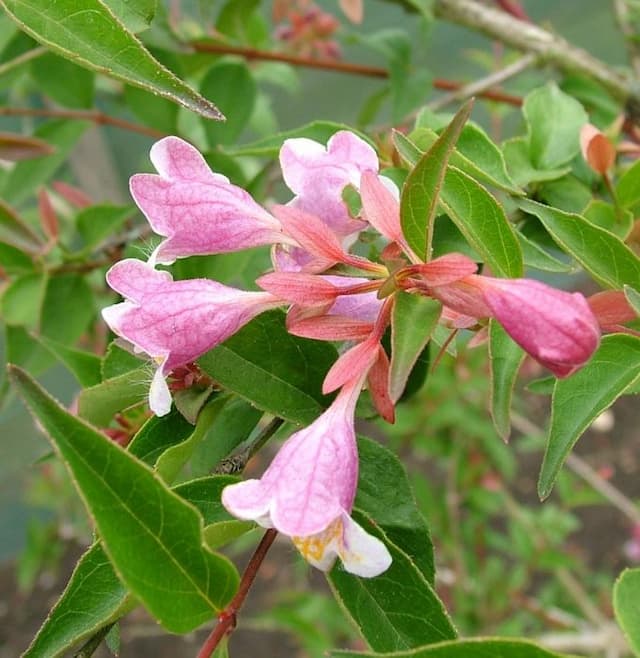Tatarian Honeysuckle Lonicera tatarica 'Hack's Red'

ABOUT
The Lonicera tatarica 'Hack's Red', commonly known as Tatarian honeysuckle 'Hack's Red', is a notably attractive shrub. Its most striking feature is its abundance of small, trumpet-shaped flowers, which boast a deep, reddish-pink hue - a color that serves as a wonderful accent in garden settings. These flowers, which bloom profusely in the springtime, are not only appealing to the eye but also to a variety of pollinators that are drawn to their sweet nectar. The leaves of the Tatarian honeysuckle 'Hack's Red' are equally distinguishable. They offer a lush, green backdrop throughout the growing season, which makes the red of the flowers stand out even more. In shape, the leaves are simple and ovate with a slightly pointy tip, yet they look quite robust, clinging on to branches that can exhibit a somewhat arching habit. As the flowering season progresses, these flowers give way to small red berries that are typically favored by birds, adding an extra layer of interest to the plant and providing food for wildlife in the garden. The bark of the plant is less pronounced but still contributes to the overall aesthetic with its subtle, textured quality that is typical of many shrubs. Overall, the Tatarian honeysuckle 'Hack's Red' is characterized by its vibrant red flowers, green foliage, and wildlife-friendly berries, it stands out among garden plants for its striking color and the lively activity it encourages in the landscape.
About this plant
 Names
NamesSynonyms
Tatarian Honeysuckle, Tatar Honeysuckle, Hack's Red Honeysuckle.
Common names
Lonicera tatarica 'Hack's Red'.
 Toxicity
ToxicityTo humans
Tatarian honeysuckle can be toxic to humans if ingested. The berries contain saponins and cyanogenic glycosides, which can cause symptoms such as vomiting, diarrhea, and abdominal pain. In severe cases, ingestion may lead to respiratory failure and death, though such extreme reactions are rare. Care should be taken to prevent children from eating the berries.
To pets
Tatarian honeysuckle is also toxic to pets, such as cats, dogs, and horses. The plant, particularly the berries, contains compounds that can cause gastrointestinal upset, including vomiting and diarrhea. In some cases, more severe symptoms such as difficulty breathing and increased heart rate may occur, especially if a substantial amount of the plant is ingested. Owners should prevent their pets from consuming this plant to avoid potential poisoning.
 Characteristics
CharacteristicsLife cycle
Perennials
Foliage type
Deciduous
Color of leaves
Green
Flower color
Red
Height
8 feet (2.4 meters)
Spread
10 feet (3 meters)
Plant type
Shrub
Hardiness zones
3
Native area
Asia
Benefits
 General Benefits
General Benefits- Attractive Flowers: The plant produces vibrant red flowers that add a splash of color to gardens and landscapes.
- Wildlife Attraction: Its flowers are known to attract butterflies and hummingbirds, enhancing the biodiversity of the area.
- Drought Tolerance: Once established, Lonicera tatarica 'Hack's Red' is tolerant of drought, making it a suitable choice for regions with low rainfall.
- Hardiness: The plant is resilient to low temperatures, making it appropriate for growing in colder climates.
- Fast Growth: It is a fast-growing shrub, allowing for quick establishment and filling in spaces in the garden.
- Ease of Care: It requires minimal maintenance once established, which can be ideal for both novice and experienced gardeners.
- Screening: Because of its dense growth habit, it can be used as a privacy screen or to hide unsightly views.
- Erosion Control: The plant's root system helps stabilize soil and control erosion on slopes and banks.
- Fall Color: In addition to its spring flowers, Lonicera tatarica 'Hack's Red' provides interest in the fall with its foliage changing to attractive yellow shades.
- Adaptability: It can adapt to a wide range of soil types, from clay to sandy soils, provided they are well-drained.
 Medical Properties
Medical PropertiesThis plant is not used for medical purposes.
 Air-purifying Qualities
Air-purifying QualitiesThis plant is not specifically known for air purifying qualities.
 Other Uses
Other Uses- Tatarian honeysuckle wood can be used for carving or inlay work, as it is hard and fine-grained.
- During seasonal celebrations, Tatarian honeysuckle branches may be used as a decorative element due to their attractive flowers.
- Extracts from Tatarian honeysuckle berries could potentially be used as a natural dye for fabrics or artwork, providing shades of red and purple.
- The robust growing nature of Tatarian honeysuckle makes it suitable for erosion control on banks and slopes.
- The plant can serve as a privacy screen or living fence in gardens and along property lines due to its dense foliage.
- Tatarian honeysuckle is sometimes planted to provide shelter and nesting sites for birds within a wildlife-friendly garden.
- When dried, the branches and twigs can be used for kindling or in the creation of small handcrafted items like wreaths.
- The plant's ability to spread quickly can be utilized for covering unsightly areas like old stumps or dilapidated structures in gardens.
- In landscape design, Tatarian honeysuckle is used to create focal points with its vibrant red flowers when in bloom.
- Some cultures might use the blooming of Tatarian honeysuckle as a seasonal indicator for agricultural events, such as when to plant or harvest certain crops.
Interesting Facts
 Feng Shui
Feng ShuiThe Tatarian honeysuckle is not used in Feng Shui practice.
 Zodiac Sign Compitability
Zodiac Sign CompitabilityThe Tatarian honeysuckle is not used in astrology practice.
 Plant Symbolism
Plant Symbolism- Love and Devotion: The Tatarian honeysuckle, like many honeysuckles, is often associated with love and the strong bonds of devotion due to its entwining growth habit, symbolizing the interconnectedness of two individuals.
- Invisibility: With its dense foliage, the Tatarian honeysuckle can represent the idea of protection or hiding something, offering a symbolic meaning of invisibility or keeping secrets.
- Generosity: Honeysuckles are abundant in their nectar, and as the Tatarian honeysuckle exhibits this trait, it can symbolize the act of giving and generosity.
 Water
WaterTatarian honeysuckle 'Hack's Red' should be watered deeply when the soil feels dry to the touch, which typically means once a week during active growth in the spring and summer. Adjust the frequency during cooler months to every two to three weeks, allowing the soil to dry out slightly between waterings. Provide about 1 to 1.5 gallons of water at each watering session to ensure the moisture reaches the root zone. During periods of drought or extreme heat, you might need to water more frequently. Always avoid overhead watering to prevent fungal diseases, and instead, water at the base of the plant.
 Light
LightTatarian honeysuckle 'Hack's Red' thrives in full sun to partial shade. The ideal location is a spot where it receives at least 6 hours of direct sunlight daily. If planted in partial shade, the flowering may be reduced. Avoid locations with harsh afternoon sun in very hot climates, as this can stress the plant.
 Temperature
TemperatureTatarian honeysuckle 'Hack's Red' is quite cold-hardy and can survive winter temperatures as low as -30 degrees Fahrenheit. The ideal growing temperatures for this plant range between 60 and 75 degrees Fahrenheit during its active growth period. It can tolerate summer heat well but should be monitored during extreme heat waves to ensure it receives adequate watering.
 Pruning
PruningTatarian honeysuckle 'Hack's Red' should be pruned to maintain shape, remove any dead or damaged branches, and promote vigorous growth. The best time to prune is late winter or early spring before new growth starts. Occasional pruning throughout the growing season may also be needed to shape the plant or control its size. It is a robust plant and can tolerate heavy pruning if necessary.
 Cleaning
CleaningAs needed
 Soil
SoilTatarian Honeysuckle 'Hack's Red' thrives best in well-draining soil that is rich in organic matter. A blend of garden soil, compost, and peat moss can create an ideal environment. Soil pH for this plant should be between 6.0 and 8.0 for optimal growth.
 Repotting
RepottingTatarian Honeysuckle 'Hack's Red', being a large shrub, typically does not require frequent repotting and is usually planted directly in the ground. In a garden setting, repotting is not applicable.
 Humidity & Misting
Humidity & MistingTatarian Honeysuckle 'Hack's Red' is adaptable to a wide range of humidity levels and does not require specific humidity conditions, making it suitable for average outdoor environments.
 Suitable locations
Suitable locationsIndoor
Grow in bright light, prune to shape, ample space.
Outdoor
Full sun, well-drained soil, hardy shrub, moderate water.
Hardiness zone
4-9 USDA
 Life cycle
Life cycleThe life cycle of Tatarian honeysuckle 'Hack's Red' begins with seed germination, triggered by suitable soil moisture and temperature conditions. Following germination, the seedling stage involves the growth of the first leaves and a root system. The vegetative stage sees rapid growth of the plant, with development of a sturdy stem, more leaves, and the formation of branches. During the flowering stage, which typically occurs in late spring to early summer, 'Hack's Red' produces pink to red blossoms that attract pollinators. Following pollination, the plant enters the fruiting stage, developing small red to orange berries that mature by late summer or autumn, which are subsequently dispersed by birds and other wildlife. Finally, as a perennial, Tatarian honeysuckle 'Hack's Red' enters a period of dormancy during the winter, with leaves falling off and growth ceasing until conditions become favorable again in spring.
 Propogation
PropogationPropogation time
Spring-Early Summer
Tatarian Honeysuckle 'Hack's Red' can be effectively propagated through softwood cuttings taken in late spring to early summer. To propagate by cuttings, choose healthy new growth and make a cutting of about 4-6 inches (10-15 cm) in length. The bottom inch (approximately 2.5 cm) of the cutting should be stripped of leaves and dipped in rooting hormone to encourage root development. Plant the cutting in a well-draining soil mix, ensuring at least two sets of leaf nodes are above the soil surface. The cutting needs to be kept moist and placed in indirect light until roots have established, which usually takes several weeks. Once the cuttings have rooted, they can be transplanted into individual pots or prepared garden beds to continue growing into mature Tatarian Honeysuckle plants.







![Himalayan honeysuckle [Golden Lanterns]](/_next/image?url=https%3A%2F%2Fplants-admin.emdemapps.com%2Fimages%2Fplants%2F%2Fimages%2F604b55302cc87.png&w=640&q=75)

